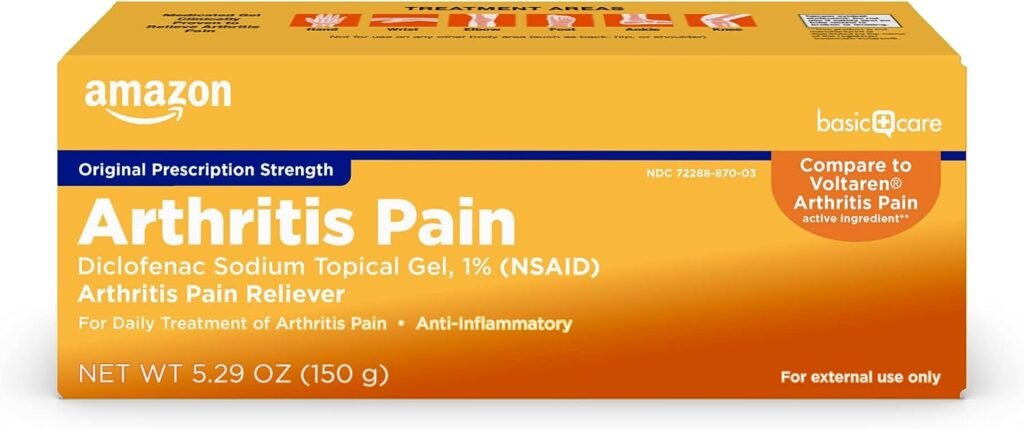How Topical Analgesics Like Diclofenac Work – The Science of Targeted Pain Relief
How Do Topical Analgesics Like Diclofenac Gel Actually Work?
If you’ve ever wondered how topical analgesics like Diclofenac work to relieve pain, you’re in the right place. In this article, we’ll explore the mechanisms behind these pain-relieving creams and explain how they can provide effective relief for a variety of common ailments.
Whether you’re dealing with muscle soreness, arthritis, or even just a mild headache, understanding how these topical analgesics work can help you make informed decisions about your pain management. So, let’s dive in and uncover the science behind these popular pain-relieving gels.
Mechanism of Action of Topical Analgesics
Topical analgesics are medications designed to provide pain relief directly to the site of application on the skin. They offer several advantages over systemic analgesics, such as reduced systemic side effects and a targeted approach to pain management. The mechanism of action of topical analgesics involves localizing pain relief, inhibiting prostaglandin synthesis, reducing inflammation, and blocking pain signals.
Localizing Pain Relief
One of the primary mechanisms of topical analgesics is their ability to directly localize pain relief to the site of application. By applying the medication directly to the affected area, you can target the specific region causing you discomfort. This localized effect helps in providing rapid and targeted pain relief, allowing you to focus on daily activities without the limitations of pain.
Inhibiting Prostaglandin Synthesis
Prostaglandins are lipid compounds that play a crucial role in the inflammation process and in transmitting pain signals to the brain. Topical analgesics, such as diclofenac gel, work by inhibiting the synthesis of these prostaglandins. By blocking their production, the medication reduces inflammation and subsequently alleviates pain. This mechanism helps to address the root cause of pain and provides long-lasting relief.
Reducing Inflammation
Inflammation is a common process that occurs in response to tissue damage or injury. It is characterized by redness, swelling, and pain. Topical analgesics work by reducing inflammation at the site of application. This can help relieve symptoms associated with conditions like arthritis, sprains, and sports injuries. By reducing inflammation, these medications promote healing and improve overall comfort.
Blocking Pain Signals
Pain signals are transmitted from the site of injury or inflammation to the brain through nerve fibers. Topical analgesics can interfere with these pain signals, either by numbing the area or by inhibiting the transmission of pain signals to the brain. This blockage helps to interrupt the pain pathway and provide instantaneous relief. By targeting the pain signals directly, topical analgesics offer effective pain management without affecting other parts of the body.
Understanding Diclofenac Gel and How Topical Analgesics Like Diclofenac Work
Diclofenac gel is a commonly used topical analgesic that utilizes the mechanisms mentioned above to provide relief from pain and inflammation. It contains the active ingredient diclofenac, which belongs to a class of medications known as nonsteroidal anti-inflammatory drugs (NSAIDs). Diclofenac gel is widely used for conditions such as osteoarthritis, rheumatoid arthritis, and muscle strains.
Composition of Diclofenac Gel
Diclofenac gel typically consists of diclofenac diethylamine, which is the active ingredient responsible for its analgesic and anti-inflammatory properties. It also contains various inactive ingredients such as carbomers, propylene glycol, and isopropyl alcohol. These components help to improve the stability and absorption of the medication into the skin.

Skin Penetration and Absorption
After applying diclofenac gel to the skin, it undergoes a process called percutaneous absorption, where the medication penetrates the superficial layers of the skin and enters the bloodstream. Factors such as skin thickness and integrity, as well as the formulation of the gel, can influence the rate and extent of absorption. The gel’s formulation is designed to optimize skin penetration and ensure the drug reaches its target site effectively.
Effects on Localized Pain and Inflammation
Diclofenac gel provides localized pain relief and reduces inflammation by targeting the affected area directly. The active ingredient, diclofenac, inhibits the production of prostaglandins at the site of application, reducing pain and swelling. Its anti-inflammatory properties help to alleviate the symptoms associated with various musculoskeletal conditions, making it a popular choice for managing pain in localized areas.
Factors Affecting Efficacy and Absorption of Topical Analgesics
While topical analgesics like diclofenac gel can be highly effective, several factors can influence their efficacy and absorption. It is important to consider these factors to ensure optimal results and avoid any potential interactions or adverse effects.
Skin Integrity and Permeability
The condition of your skin plays a significant role in the absorption of topical analgesics. Damaged or compromised skin barriers may affect the medication’s ability to penetrate and provide relief. Additionally, differences in skin thickness and blood flow can impact the absorption rate. It is important to ensure the application site is clean, intact, and free from any open wounds or infections to maximize the penetration of the medication.
Application Technique and Frequency
Proper application technique is crucial for the effective delivery of topical analgesics. It is recommended to thoroughly clean and dry the affected area before applying the medication. Applying a thin layer of the gel and gently massaging it into the skin can improve absorption. The frequency of application will depend on the specific product and the severity of your condition. It is important to follow the instructions provided by your healthcare provider or the medication’s packaging for optimal results.
Drug Interactions and Precautions
As with any medication, it is important to be aware of potential drug interactions and take precautions when using topical analgesics. Certain medications, such as blood thinners, can increase the risk of bleeding or bruising when used in combination with topical analgesics. It is essential to consult with your healthcare provider or pharmacist to ensure there are no contraindications or interactions between the topical analgesic and any other medications you may be taking.
Comparison with Systemic Analgesics
Topical analgesics offer a localized approach to pain relief, differentiating them from systemic analgesics that are ingested or injected and affect the entire body. Understanding the differences between localized and systemic effects can help you make informed decisions about which approach is best for your specific needs.
Localized vs Systemic Effects
Topical analgesics like diclofenac gel provide localized effects, meaning they primarily target the area of application and provide relief from pain and inflammation in that specific region. This localized approach minimizes the risk of systemic side effects commonly associated with oral or injectable analgesics, such as gastrointestinal upset or kidney toxicity. Systemic analgesics, on the other hand, distribute throughout the body and can affect multiple systems, including the liver and digestive system.
Safety and Side Effect Profile
Topical analgesics generally have a favorable safety profile compared to their systemic counterparts. The risk of systemic side effects is significantly lower due to the limited systemic absorption of the medication. However, it is still important to be aware of potential local side effects, such as skin irritation or allergic reactions. Carefully following the application instructions and monitoring for any adverse reactions can help ensure the safe use of topical analgesics.
Clinical Uses of Topical Analgesics
Topical analgesics have a wide range of clinical uses and can effectively manage various types of pain. Understanding their applications can help guide you when considering topical analgesics as an option for pain management.
Musculoskeletal Pain
Topical analgesics are commonly used to relieve musculoskeletal pain, such as muscle strains, sprains, and overuse injuries. By directly targeting the affected area, they can provide fast-acting pain relief and reduce inflammation associated with these conditions. Topical analgesics offer a convenient and non-invasive alternative to oral medications for managing localized musculoskeletal pain.
Sports Injuries and Sprains
Sports injuries and sprains often result in localized pain and inflammation. Topical analgesics can help alleviate these symptoms, allowing athletes to recover faster and resume their activities. Their localized effect makes them a preferred choice for sports-related injuries, as they can provide targeted relief without interfering with performance or causing systemic side effects.
Arthritis and Joint Pain
Arthritis and joint pain are chronic conditions that can significantly impact daily functioning and quality of life. Topical analgesics, including diclofenac gel, are frequently used as part of a comprehensive approach to managing arthritis symptoms. They can provide localized relief, reduce inflammation in affected joints, and alleviate pain without the need for systemic medications.
Alternative Topical Analgesics
In addition to diclofenac gel, there are other topical analgesics that can be used for pain management. These alternatives offer different mechanisms of action and may be more suitable for certain individuals or conditions.
Capsaicin
Capsaicin is a compound derived from chili peppers that is often used in topical analgesics. It works by depleting substance P, a neurotransmitter involved in pain transmission. The application of capsaicin can initially cause a warming or burning sensation, which is followed by pain relief. Capsaicin-based topical analgesics are commonly used for conditions such as neuropathic pain and arthritis.
Menthol
Menthol is a cooling agent that acts as a counterirritant. It works by stimulating the cold receptors in the skin, creating a cooling sensation that helps to distract from pain. Menthol-based topical analgesics are frequently used for muscle aches, sprains, and minor bruises. Their refreshing effect provides a soothing sensation that can help manage localized pain.
Salicylates
Salicylates are compounds derived from aspirin and have analgesic and anti-inflammatory properties. They are commonly used in topical analgesics for conditions such as osteoarthritis and tendinitis. Salicylate-based products work by inhibiting prostaglandin synthesis, similar to diclofenac gel. These topical analgesics can offer relief from pain and inflammation, making them a valuable alternative to consider.
Patient Considerations and Recommendations
When using topical analgesics, it is essential to consider certain factors and follow recommendations to ensure the best possible outcome and minimize the risk of adverse effects.
Consulting with a Healthcare Provider
Before starting any new medication, including topical analgesics, it is advisable to consult with your healthcare provider. They can assess your specific condition, review your medical history and advise you on the most appropriate treatment option. They can also help determine the correct dosage and guide you in monitoring for any potential side effects or interactions with other medications.
Proper Application and Dosage
Carefully following the instructions provided with the topical analgesic is crucial for optimal results. It is important to apply the medication to clean and dry skin, ensuring that the affected area is adequately covered. Applying too much or too little can impact absorption and efficacy. If you are unsure about the correct dosage or application technique, consult your healthcare provider or pharmacist for guidance.
Monitoring for Adverse Effects
While topical analgesics are generally well-tolerated, it is important to be aware of any potential adverse effects. Skin irritation, redness, or allergic reactions can occur in some individuals. If you experience any unusual or concerning symptoms after applying a topical analgesic, discontinue use and consult with your healthcare provider. They can help determine if the reaction is related to the medication or if it may require further investigation.
Research and Future Developments
The field of topical analgesics continues to evolve, with ongoing research focusing on novel delivery methods, combination formulations, and exploring additional mechanisms of action.
Novel Delivery Methods
Researchers are constantly exploring innovative ways to enhance the delivery of topical analgesics. This includes the development of transdermal patches, iontophoresis, and nanoparticles to improve drug penetration and optimize efficacy. These advancements aim to provide more effective and convenient pain management options for individuals requiring topical analgesics.
Combination Formulations
Combining multiple active ingredients in a single topical analgesic formulation is an emerging area of research. The synergistic effects of different compounds may provide enhanced pain relief and anti-inflammatory benefits. Combination formulations can potentially offer a broader spectrum of therapeutic action and address multiple factors contributing to pain and inflammation.
Exploring Additional Mechanisms of Action
While the current mechanisms of action of topical analgesics are well-established, researchers are continuously investigating new pathways and targets for pain management. This includes studying the role of neuropeptides, ion channels, and anti-inflammatory mediators. By uncovering additional mechanisms of action, scientists hope to develop more targeted and efficient topical analgesics in the future.
Conclusion
Topical analgesics are a valuable option for localized pain relief and inflammation management. They work by localizing pain relief, inhibiting prostaglandin synthesis, reducing inflammation, and blocking pain signals.
Diclofenac gel, in particular, is a widely used topical analgesic that effectively provides relief from various musculoskeletal conditions. Factors such as skin integrity, application technique, and drug interactions can influence the efficacy and absorption of these medications. Topical analgesics offer a localized approach to pain management, reducing the risk of systemic side effects. They are commonly used for musculoskeletal pain, sports injuries, and arthritis.
Alternative topical analgesics, including capsaicin, menthol, and salicylates, can provide additional options depending on individual needs. It is important to consult with healthcare providers, follow proper application techniques, and monitor for adverse effects when using topical analgesics.
Ongoing research is focused on novel delivery methods, combination formulations, and exploring additional mechanisms of action to further improve the efficacy and convenience of topical analgesics. With the continuously evolving field of topical analgesics, individuals can benefit from targeted pain relief and improved quality of life.

